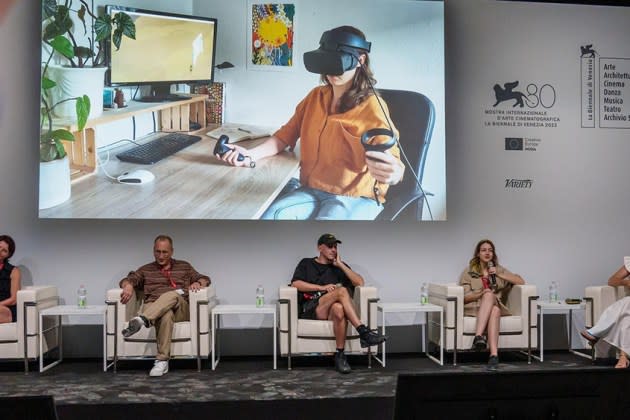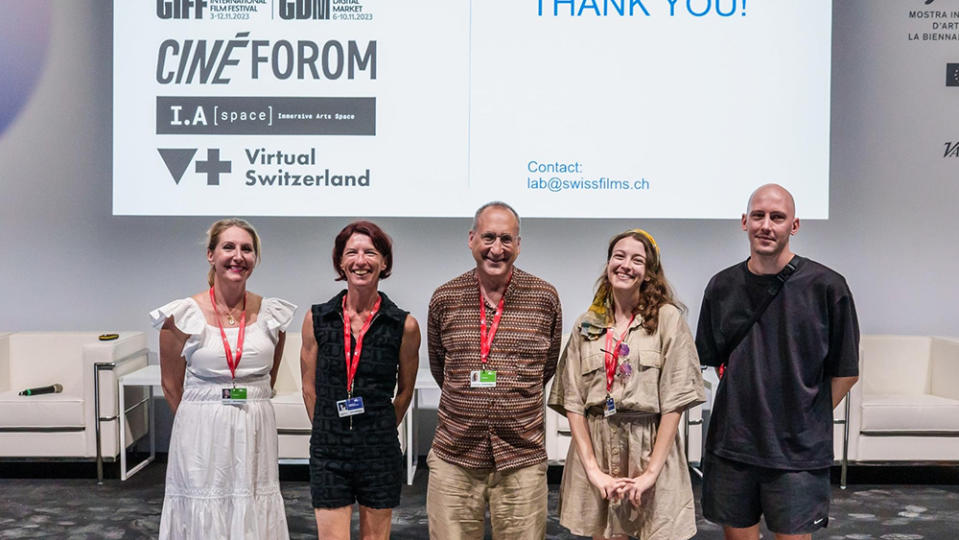Venice Offers New Senses and Directions in XR: ‘All Projects Involve the Human Body, We’re Not Just Sitting’

A Sensory Storytelling in XR panel which took place at the Venice Immersive Island, part of the Venice Film Festival, sketched new directions being taken in Switzerland.
Chaired by Laetitia Bochud, of Virtual Switzerland, the panel featured a range of experts from different parts of the creative field. Director Zoe Roellin, whose piece “Perennials” is one the 28 pieces featured in the competition at Venice this year, spoke of how her work aspires to immerse the viewer in a real location, based on her grandparents’ vacation home. “The emotions are catalyzed by the place. Realism and stylisation are balanced. I wanted to ground the viewer.”
More from Variety
A more stylized vision was offered by Patrick Muroni, who outlined a work in progress entitled “Rave.” Also based on a real environment, the visuals are activated by the participant’s movements. “The dance provokes the animation of luminous particles which gradually illuminate the rave location and the other dancers to the sound of techno music. We use photogrammetry of a real place in Germany.” The story features an audio track of the real life memories of a raver.
As a “movement artist,” Susana Panadés Díaz is an expert in mocap technology and the lead dancer of the Gilles Jobin Dance Company. She told Variety how the dance company had become “a virtual lab/studio” available for other companies and dancers to learn and experiment with the possibilities of the technology, and boasting 42 mocap optical cameras.
“We focus on the body and the spaces we create between each other, the dynamics and the narrative we construct without words but only with movement.” Their latest project – entitled “Sunset Motel” – is based on Thomas Ott’s scratchboard designs. The story is told without language or facial expression. “I am the integrator of unity,” Diaz says. “When we became digital, I could see my choreography from each angle. I have to make the bridge between the technology and the dance part and then I have to integrate everything into the 3D environment. In the theater dance is minimalist and you never see yourself. But working with VR we always have feedback with the screens.”
The director of the Immersive Arts Space at the Zurich University of the Arts, Christopher Salter, offered a more global and critical vision of the art form. In the Immersive Art Space, 15 researchers, trained in game design and computer science as well as critical practice, are seeking a critical approach to XR, taking issue with its ableist bias for instance.
Salter defined XR as “entangling the human senses and body in a technological environment,” and pointed out that with the technologies of the Oculus Quest 3 due out next month and Apple Vision Pro coming out early in 2024, the stage is potentially set for a move forward in XR. He outlined a recent project “Animate” (2022), which mixed live theater, XR and a communal experience. Importantly, Salter noted that VR is very different from cinema, as illustrated by the projects presented. “All these projects involve the human body. We’re not just sitting, like in the cinema. The most interesting sense is proprioception, the sense of being in a body. When we get to a place where the physical environment matters more than the wrap-around environment of headsets, we become embedded in this world.”

Best of Variety
Sign up for Variety’s Newsletter. For the latest news, follow us on Facebook, Twitter, and Instagram.


